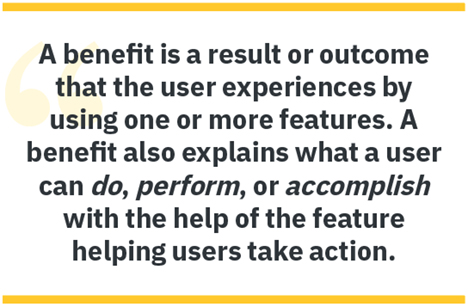By Girish Hasabnis | Senior Member
How to better author business-focused content and how emphasizing product benefits can help your readers use products to their fullest potential.
When creating technical content, technical writers often face a dilemma of writing the features and benefits of the product. Beyond doubt, everyone understands that the features distinguish the product from its competitors. If a technical writer authors content for features, there is a chance of the content becoming feature-focused. Although feature-focused documentation played a vital role previously, the technical writers must author content these days after considering the functionality and features, and most importantly the benefits of the product. This article tries to explain the concept of features and benefits, the difference between them, and finally how technical writers can author the content for features.
What Is a Feature?
Dictionary.com explains a feature as a prominent and conspicuous part or characteristic. A feature can also be explained with the help of the following definitions:
- A feature is the thing that your product contains or is. This is typically the functionality that your product offers and enables its users to do something.
- A feature answers the what and (sometimes) how questions for users.
- A feature addresses the common problems that the users face and provides competitive advantages to them.
- A feature also provides factual information to the user. In other words, a feature is what something is.
- Features are the characteristics or aspects of your product, which can be technical.
- ProductPlan.com defines a feature as a product’s attributes that deliver some value to its end-users and differentiate a product in the given market. A feature of a software product can include any functionality, capability, and even its visual characteristics.
What Are the Benefits?
A benefit is a result or outcome that the user experiences by using one or more features. A benefit also explains what a user can do, perform, or accomplish with the help of the feature helping users take action. A benefit generally has a positive impact on the user or removes the negative impact that the user has. A benefit can also explain what a feature means to its user.
Why Are Benefits Important?
- The benefits help a user to answer the questions—what’s in it for me and what will this feature do for me?
- The benefit explains to the user how the feature is going to have a positive and valuable impact on the work.
- Explaining benefits explicitly in the documentation helps the user understand the uses of the feature that are not so obvious.
- A benefit answers the why question forthe user.

A benefit is a result or outcome that the user experiences by using one or more features. A benefit also explains what a user can do, perform, or accomplish with the help of the feature helping users take action.
Guidelines for Identifying the Benefits of a Feature and Authoring Content
While authoring content for the identified feature, you can try to answer the question—what’s in it for me—from your user’s perspective. Answering this question or finding information about this question might lead you to understand the benefit that the user will get by using the identified feature, and then author the content. You might also understand the challenge or problem that the users faced previously and how the newly developed feature tries to overcome that challenge. You can try to understand the positive impact that the feature offers or the negative impact that the feature eliminates.
Table 1: Few examples of features and benefits
|
Feature |
Describing only features and their specifications |
Describing benefits along with the features and specifications |
|
3D viewer |
The 3-dimensional viewer displays the CAD design of the gearbox assembly in 360 degrees. |
Use the 3-dimensional viewer to view the CAD design of the gearbox assembly in various angles and ensure that the distances between the gears are within the tolerance limits. |
|
Render a document |
A document can be rendered in different file formats. For example, a Microsoft Word document can be rendered into a PDF document. |
Render a document to different file formats so that the other users can access and read it. Rendering a document to a different file format also helps you ensure that the shared users do not edit the source document. For example, render a Microsoft Word document into a PDF document and then share the PDF document with other users. |
|
Track changes in Word |
Track changes help you mark the changes and suggestions that you make to the original document. |
Turning on Track Changes gives you and your coworkers a way to make changes that are easy to spot. The changes are like suggestions that you can review, and then remove them or make them permanent. |
Source: https://support.microsoft.com/en-us/office/track-changes-in-word-197ba630-0f5f-4a8e-9a77-3712475e806a#:~:text=Open%20the%20document%20that%20you,to%20turn%20on%20track%20changes.
For identifying the benefits of a feature, you might need to perform some research, such as talking to various stakeholders to increase your subject or domain knowledge and to visualize how users would use the feature. You can also make an exhaustive list of the features and author benefits that each feature offers and the actions that a user can take. This exhaustive list of features and their benefits can also be a good starting point for you to author the content. Finally, there are many more ways than the ones that are listed here. You can see what works best for you.
Places in a Document Where Benefits Can Be Better Explained
You can consider explaining the benefits at the places in a technical document including the following ones:
- Short paragraphs
- Introductions
- Tables
- Notes and footnotes
- Annotations including graphics, multimedia, images, and diagrams
- Any other place that you think explaining benefits is required.
When Should You Not Explain Benefits?
Sometimes explaining specifications of a feature is just enough. You need not explain its benefits. The following list describes some of the situations when feature description is enough:
- The user is technical enough and is more interested to understand the features and their technical aspects and specifications.
- The benefits are obvious and very common.
- You are explaining the procedures.
How Much Focus Should Be Spent on Explaining Benefits?
Considering the technicality of the subject and the user for whom you are authoring the information, the right balance must be made between authoring the technical information of a feature and describing its benefits. Marketing and sales documents tend to include more benefits-related information so that the reader can purchase the product. However, the technical documents should include the benefits-related information concisely and succinctly.
Conclusion
While authoring the detailed information of a feature is important, a technical writer must also author the benefits of the feature so that the users can appreciate the feature and its use.
References and further readings
Dictionary.com https://www.dictionary.com/browse/feature
Product Plan.com https://www.productplan.com/glossary/features/
 Girish Hasabnis (girishhasabnis@gmail.com) is an STC Senior Member and a senior information developer at Siemens Digital Industries Software (https://www.sw.siemens.com/). He has 17+ years of experience working on several projects from various industries including supply-chain management, telecommunications, healthcare, banking, electronic design automation (EDA), geographical information systems (GIS), and global positioning system (GPS). He enjoys producing how-to and conceptual video. Girish also practices search engine optimization (SEO) techniques in technical documentation.
Girish Hasabnis (girishhasabnis@gmail.com) is an STC Senior Member and a senior information developer at Siemens Digital Industries Software (https://www.sw.siemens.com/). He has 17+ years of experience working on several projects from various industries including supply-chain management, telecommunications, healthcare, banking, electronic design automation (EDA), geographical information systems (GIS), and global positioning system (GPS). He enjoys producing how-to and conceptual video. Girish also practices search engine optimization (SEO) techniques in technical documentation.


